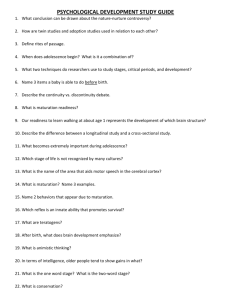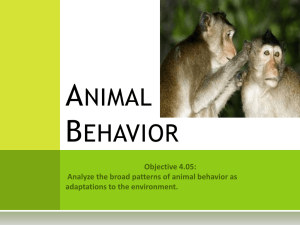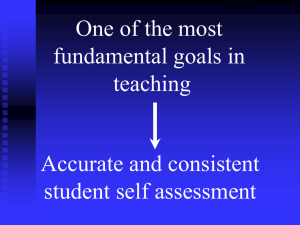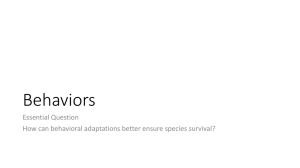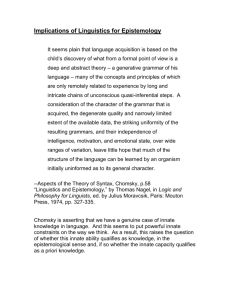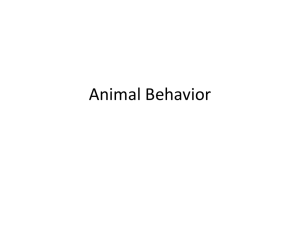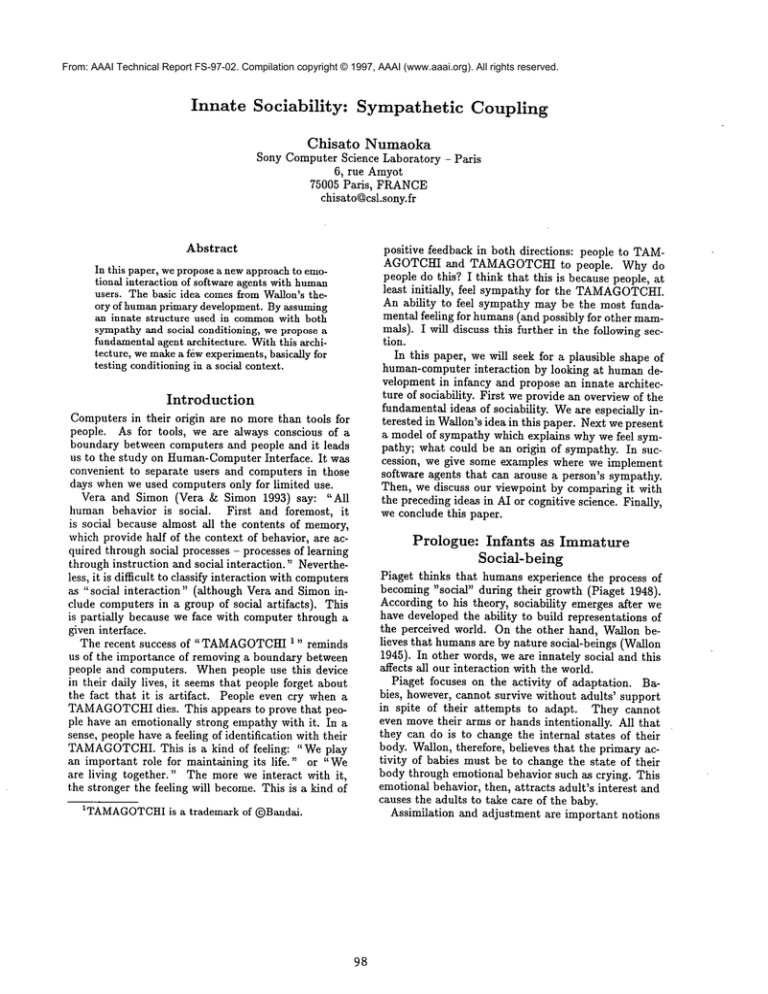
From: AAAI Technical Report FS-97-02. Compilation copyright © 1997, AAAI (www.aaai.org). All rights reserved.
Innate
Sociability:
Sympathetic
Chisato
Coupling
Numaoka
Sony Computer Science Laboratory - Paris
6, rue Amyot
75005 Paris,
FRANCE
chisato@csl.sony.fr
Abstract
In this paper, we propose a new approach to emotional interaction of software agents with human
users. The basic idea comes from Wallon’s theory of human primary development. By assuming
an innate structure used in commonwith both
sympathy and social conditioning, we propose a
fundamental agent architecture. With this architecture, we makea few experiments, basically for
testing conditioning in a social context.
Introduction
Computers in their origin are no more than tools for
people. As for tools, we are always conscious of a
boundary between computers and people and it leads
us to the study on Human-Computer Interface.
It was
convenient to separate users and computers in those
days when we used computers only for limited use.
Vera and Simon (Vera & Simon 1993) say: "All
human behavior is social.
First and foremost, it
is social because almost all the contents of memory,
which provide half of the context of behavior, are acquired through social processes - processes of learning
through instruction and social interaction."
Nevertheless, it is difficult to classify interaction with computers
as "social interaction"
(although Vera and Simon include computers in a group of social artifacts).
This
is partially
because we face with computer through a
given interface.
The recent success of "TAMAGOTCHI
1 ,, reminds
us of the importance of removing a boundary between
people and computers. When people use this device
in their daily lives, it seems that people forget about
the fact that it is artifact.
People even cry when a
TAMAGOTCHI
dies. This appears to prove that people have an emotionally strong empathy with it. In a
sense, people have a feeling of identification with their
TAMAGOTCHI.
This is a kind of feeling:
"We play
an important role for maintaining its life." or "We
are living together."
The more we interact with it,
the stronger the feeling will become. This is a kind of
1TAMAGOTCHI
is a trademark of (~.)Bandal.
98
positive .feedback in both directions: people to TAMAGOTCHI and TAMAGOTCHI to people.
Why do
people do this? I think that this is because people, at
least initially,
feel sympathy for the TAMAGOTCHI.
An ability to feel sympathy may be the most fundamental feeling for humans (and possibly for other mammals). I will discuss this further in the following section.
In this paper, we will seek for a plausible shape of
human-computer interaction
by looking at human development in infancy and propose an innate architecture of sociability. First we provide an overview of the
fundamental ideas of sociability. We are especially interested in Wallon’s idea in this paper. Next we present
a model of sympathy which explains why we feel sympathy; what could be an origin of sympathy. In succession, we give some examples where we implement
software agents that can arouse a person’s sympathy.
Then, we discuss our viewpoint by comparing it with
the preceding ideas in AI or cognitive science. Finally,
we conclude this paper.
Prologue: Infants as Immature
Social-being
Piaget thinks that humans experience the process of
becoming "social" during their growth (Piaget 1948).
According to his theory~ sociability emerges after we
have developed the ability to build representations of
the perceived world. On the other hand, Wallon believes that humans axe by nature social-beings (Wallon
1945). In other words, we are innately social and this
affects all our interaction with the world.
Piaget focuses on the activity of adaptation. Babies, however, cannot survive without adults’ support
in spite of their attempts to adapt. They cannot
even move their arms or hands intentionally.
All that
they can do is to change the internal states of their
body. Wallon, therefore, believes that the primary activity of babies must be to change the state of their
body through emotional behavior such as crying. This
emotional behavior, then, attracts adult’s interest and
causes the adults to take care of the baby.
Assimilation and adjustment are important notions
in Piaget’s theory whereas attitudes and emotion are
central to Wallon’s ideas. Wallon does not ignore the
observation of infants trying to assimilate the world
and to adjust their schemesif necessary, but argues
that it is not a primary activity of babies in the early
stages of life. He does not think that humansbecome
social at the end of this type of activity as Piaget suggests. He stresses rather activity as a social-being,
which is emotional behavior. He thinks that human
developmentis a process of developing a better relationship for mutual understanding through emotional
behavior since our own growth levels depend on individuals.
To summarize, Piaget focuses on a highly intelligent skill of social interaction whereasWallonconsiders primitive interaction as a sign of social interaction.
In software agents, both levels of sociability have to
be considered, although we hitherto have dealt mainly
with the former level of sociability. It is worth considering sociability as an innate characteristic of humans
to compensatefor their inability to survive in the world
alone.
Inside
Outside
’%
exterofector
(D~
m1:ero1:ecl:or(~,) ~
\
’
interoceptor (A)
~_l
exteroceptor (C)
’
jJ
Figure 1: Innate Structure
that we need for next generation human-computerinteraction; all participants work in a chain as if they
were parts of a system or self. In a sense, this is a
basis of cooperation.
Sympathetic Mutual Understanding
with Innate Structure
Sympathy: a basis
of parental
affection
Here I attempt to understand whymothers try to satisfy their babies desire (in other words, whypeople can
understand other’s desire to be satisfied) in extension
of Wailon’s idea. First of all, we will present a simplified model of humanactivity in Figure 1. Wecan
think of a metabolic cycle in the center in association
with the hypothalamus 2. It is reasonable to assume
four types of input/output: (A) interoceptor (e.g.
sense of hunger), (C) exteroceptor (e.g. producing
pression), (D) exterofector (e.g. looking / hearing
feeling / tasting / smelling), and (E) interfector (e.g.
regulation of respiration or heartbeat).
Let us take an example; feeling hunger. Whena
baby feels hunger, a trigger A stimulates a cycle B.
In part, B activates a behavior of crying D as well as
applying hormonal/neural regulation E. The voice of
crying is heard by him/herself C and this affects B as a
positive feedback in relation to hunger. Therefore this
initiates conditioning with an unsatisfied experience.
Even after he/she grows up, this conditioning may
remain at some level. If this is true, then when an
adult hears the voice of an infant, C’, crying for nutrition, this mayautomatically recall an emotional feeling of hunger in B’ as if he / she were really hungry
(Figure 2). Of course, reality must be muchcomplex.
Nevertheless, I believe that conditioning concerninglife
maintenance may remain consciously or unconsciously
in memory.
Conditioned reflex
Pavlov discovered that a mental factor affects the secretion of gastric and salivary glands. Based on this
discovery he made a famous experiment. He repeated
a procedure of giving food just after having applied a
conditioned stimulus, in effect, a metronomicsound at
a constant frequency. This is the so-called conditioned
reflex.
Babies establish an emotionally symbiotic relationship 2 to 3 months after birth. According to Wallon, throughout this time, conditioned reflex is formed
based on their two major desires of ingestion and posture change. Here the meaning of conditioned reflex
is the same as that of Pavlov except that there is no
artificially provided conditioned stimulus.
Whenbabies feel hunger through interoceptor,
there is no other way for them than responding
with propriofector or interfector by such an action
as crying .... the representation of posture and
emotionis conveyedto his / her mother, and eventually mother satisfies his / her desire. Through
the repetition of this activity betweena baby and
his / her mother, the action of crying becomesa
symbolindicating a desire for food. This is clearly
conditioning .... Namely,we can understand WalIon’s idea that cooperative relationship with others is formed through classical conditioning regarding posture and emotion (Hamada1994).
2The hypothalamusis an autonomousnervous system,
the most essential organ for the maintenanceof life. It
is also assumed to be the central cause of emotional
expressions.
Wallon states: "infants are tightly connected with
their familiar people and can hardly separate themselves from others." This is actually an important idea
99
learning system (L)
central regulator (R)
Figure 2: A Mechanismof Sympathy
a
So, this is a plausible reason whywe feel sympathy with each other, particularly for humanexpressions
concerning life maintenance. In analogy, we could create software agents with which humanusers feel sympathy if these agents have a similar innate structure
to condition themselves; with inputs from others, augmentedwith a signal originally produced by themselves
and captured by their ownorgan.
Crying is not originally
emotional
Following the idea of Wallon, we can postulate that a
given emotional behavior, crying, will not be bounded
to such a particular sense as we describe it as, for example, painful, when a baby is born. Fromthe behaviorist point of view, crying is just a result of makingthe
best effort to maintain its life system. Whenhungry, a
stomach contracts. To avoid hunger for the moment,
it might be better to expand the stomach so it does
not feel empty. This recovery regulation maycause an
action: to take in as muchair as possible. This in turn
mayinvolve motions of the diaphragmand the trachea
and as a result a cry will be produced. Therefore, we
could say that the behavior of crying is simply a result
of posture regulation.
By repeating the same action and undergoing
parental reaction, babies will be conditioned. After
that, they maylearn howeffectively they cry by connecting their observation of the world with their mental
condition.
Based on this idea, we could imagine a fundamentaJ innate architecture as in Figure 3. Here, there is
a central regulator (which is assumed to be the hypothalamus) and a learning system. The other four
modulesmaybe, for example: 1, a stomach; 2, an eating module;3, a vocal system; and 4, an acoustic system. Arrowsa, b, and c indicate respectively a sound
output, a sound input, and food. Arrows x, y, and z
are signals which activate destination module. Arrows
a, 13, 3’, and X are the inputs to the learning system
for conditioning. This architecture has the following
characteristics:
¯ it has an a and b pair. This pair corresponds to the
C and D pair in Figure 1.
100
Figure 3: A typical innate architecture
¯ it producesan output a so as to receive a satisfactory
input c.
¯ it inputs ~ as well as X. Aslong as it is only this agent
that produces an output (which is also received as
input b), having these two inputs is for redundancy
only. Nevertheless, what we expect is that a user
also produces an input that can be received from
the the same input port b but as an unrecognizable
signal.
Figure 4 showsa typical exampleof a time series of
digital inputs to a learning system as well as that of
state of control signals amonga central regulator and
three modules. Input /3 indicates a state of satisfaction with the nutrition. Note the relationship between
/3 and the other two inputs a and X- It is clear that the
state of satisfaction/3 changes at sometime while a is
1 and 6 is unknown(represented as a symbol x).
course, it is possible to condition this agent even if we
consider only input c. However,it never differentiates
reasons of satisfaction; the agent achieves it whether
provided by itself or by others. It will alwaysbelieve
that a nutritional need was satisfied because it had a
corresponding desire, which is represented by a positive state of regulation signal y. It will never relate
the reason to another person’s support. It becomes
possible to discriminate two cases only by receiving an
unknowninput from a user. This is the most fundamental contribution of this architecture.
Experiment
In this section, we introduce a few experiments which
embodythe innate architecture for sociability. The
goal of these experimentsis to allow agents to exhibit
a kind of conditioned reflex. Moreprecisely, we expect
t 1 ~3
X
4
:::
;;1""
y,z [::
:::]-
..~. .....
c~
o
:~
[’.i ......................
,,,
[::
:il
Basic components are now: 1) a wandering system
within a limited range of a circle where a user avatar
is in the center, 2) a distance tracker and calculator
(it generates 1 when the distance between a user and
this agent is in a defined range of a circle), 3) a sound
generator with a speaker system, and 4) a sound receiver with a microphone system. Input c is always
the position of the user.
i.~"..~i
9
, °.. ,
i. i ,:=.’1~
.i ...........
i!..:
ii4::
: ::.L!
, °.°
Discussion
In this section, we compare our idea with some preceding ideas in AI. Wewould like to emphasize that
this is new and howit compensatesfor other ideas to
producesocially intelligent agents.
,
1 !lili
0 il~li
1
1
!ffl.:(g)! 0
i1~1~1~i0
0 Z(i(i
] :,-~,a
0 i~jli
0 O0
0
(i
1
1
i~.lilili 1
!t~l~i!
i
. °.. ,
0
!1!1!1~0!
xxxx
0
.....
.......o.lf:f:
............
I.......... .....o.
Figure 4: Timeseries of inputs to a learning system
an agent to exhibit partial satisfaction only with an
input b by a user before satisfying an original desire
to obtain an input c in Figure 3. In both experiments,
we implementedthe learning system to produce a conditioned reflex by using a very simple neural network
which producedan expected satisfaction (e in Figure
whicheventually effect regulatory signals y and z),
Jukebox agent
There is an avatar of an agent in a virtual world which
plays MIDImusic. The agent wishes to continue to
hear a music but the switch to start playing music is
not under its control. The only wayto start the music
is to cry like babies. Whenthe agent finish playing a
piece of music, a list appears at a side of the avatar,
whichshowsa selection of music. If the avatar is not in
a user’s view, it cannot hear a user’s voice. Whata user
can do for the avatar is to change his/her viewpoint
and to chooseone piece of musicin the list.
This agent has basically the same architecture as
that described in Figure 3. Its basic componentsare:
1) a music player, 2) a music menumanager,3) a sound
generator with a speaker system, and 4) a sound receiver with a microphonesystem, where the reference
numbercorresponds to that in Figure 3. Menuselection is done by clicking a mouseas input c.
Navigation
with an agent
Suppose that a user is navigating through a virtual
world accompanied by an avatar of an agent. The
agent always tries to do its best to keep following the
user. Whenthe agent is outside an area wherethe user
is in the center, the agent begins to cry. If the user approaches and the agent again enters the area, it stop
crying.
i01
Behavior-based
AI
In a sense, one root of our research can be found
in literature on behavior-based AI. Brooks describes
behavior-based creatures using a so-called subsumption architecture (Brooks 1986). The important idea
that any kind of behavioral patterns that the creatures
showis groundedin sensory inputs. With the least set
of primitive behaviors, without symbolic expression,
they exhibit apparently very complex behavior. We
can see intelligence in their behavior but there is no
particular description of intelligent behavior. Brooks
calls this: "Intelligence without expression."
In the same sense, we could say: :’Emotion without expression." Wemay feel emotional expression to
an agent’s attitude. Howeverthis is not because agents
have an emotional state but because we can have a corresponding emotional feeling. Brooks’s creatures have
been criticized and our approachfaces a similar difficulty; howcan we achieve higher levels of emotional
attitudes? This is a challenging topic.
Believable
agents
Behevable agents are animated characters with emotion (Bates 1994). Bates’ believable characters have
attracted people because they can imitate human-like
expressions of emotion and create "illusion of life."
Bates is interested in believability of characters. People will have a feeling that they are living together if
they feel any kind of sympathy. For this objective,
Bates emphasizesthe role of the emotional state of the
character.
I agree with him in the sense that software agents
must demonstrate behavioral patterns, even partially,
with which we are familiar in humansociety. By so
doing, people can project their ownfeeling onto the
agents. Somestudies emphasize this point (e.g. Neurobaby (Tosa 1993) and ALIVE(Maes 1995)). Nevertheless, I found it difficult to strictly define emotional
states. As mentionedbefore, emotional expression will
basically be groundedon someparticular needs of bodily regulation.
People maysay that the needs of computers are different from those of humans, so it maynot be possi-
ble to produce similar emotional states. This is true.
Wedo not neglect this point. Our approach is to implement the smallest set of action which metaphorically resembles that of humans(e.g. crying) instead
adopting emotional states directly. Emotional states,
in my opinion, arise only when we objectively view
someone’sattitude.
Our software agents can produce an association
amonga bodily need, a related course of actions, and
an experience. Once we feel sympathy with an attitude of an agent, then if we observe a similar attitude
in the same agent, we mayproject to it an emotional
state that we have individually. An interesting question is how muchvocabulary of "emotion"-like attitude agents will produce. This is a topic of further
study.
Primate social intelligence
Wordenshows us a plausible account of howsocial intelligence will function based on the assumptionthat it
is expressed as scripts someof whichare innate and the
rest of whichcould be learned later. Scripts are simple
information structures on which three basic operations
maybe applied: intersection, inclusion, and unification. By virtue of these operations, a new script can
be learned by specializing someinnate scripts. According to (Worden1996), examplesof social intelligence
typical to primates are: to use kin relations, to habituate to calls, to learn alarm calls, rank and alliances,
emotional responses, tactical deception, and so on.
Basically, we do not intend to explain this typical social intelligence in our modelof innate sociability. I accept the idea that there must be someinnate structures
enabling Primates to exhibit social intelligence. Script
theory is very sophisticated especially for explanations.
Worden’sscript reminds us of Piaget’s scheme.
Nevertheless, I suspect that there must be morefundamental innate structure as explained in this paper.
It is an innate structure that enables infants to associate themselves with the surrounding society, we can
hypothesize that we (or some higher mammals)have
been able to abandon advanced development at birth
for immature birth because we have developed a reciprocal nature with which we sympathetically understand the others’ suffering or pain and automatically
respond with an appropriate reaction. An interesting
study wouldbe to deal with individual cases of social
intelligence with our modelof innate sociability.
pathy with each other. This feeling is especially strong
for mothers towards their babies.
Subsequently, we have described a model architecture of software agents that embodies a primary social interaction by which we may have sympathy with
them as well as by which the agents can acquire conditioned reflexes to produce social coupling of an agent
and a user. This model was implemented on a few
experiments by instantiating abstract modulesin the
architecture. The characteristics of this architecture
are that: 1) An agent produces any observable output
(e.g. voice) so as to satisfy its desire, 2) it objectively
observes the output by itself, 3) In the same channel of
observation, the agent receives an input from a user,
which is recognized as unknownand uses it together
with a desired input for learning or conditioning.
In this paper, basically, I focused on the problemof
conditioning as a primary development of social coupling necessary to maintain their lives, and applied the
idea to software agents. Wementioned the fact that
we need to test sociability of agents by using themin a
real context and to extend to the awakeningof higher
levels of sociability. It might not be so simple. Nevertheless, I believe that the idea of sympathetic coupling
between agents and users gives us one of important
aspect of a fundamentalarchitecture of social agents.
Acknowledgments
The author wishes to thank Philip Mayenfor the use
of his source code of Java Script and VRaML
file. It
was a great help in our experiments.
References
Bates, J. 1994. The role of emotion in believable
characters. Communications of the ACM37(7):122125.
Brooks, R. A. 1986. A Robust Layered Control System for a Mobile Robot. IEEE Journal o/Robotics
and Automation RA-2(1):14-23.
Hamada,S. 1994. Piaget and Wallon (in Japanese).
Minerva Shobo.
Maes, P. 1995. Situated Action: A SymbolicInterpretation. Communicationsof the A CM38(ll):108-114.
Piaget, J. 1948. La naissance de l’intelligence chez
l’enfant (2nd Edition).
Tosa, N. 1993. Neurobaby. In Visual Proceedings
of SIGGRAPH-93Tomorrow’s Realities.
ACMSIGGRAPH.
Vera, A. H., and Simon, H. A. 1993. Situated Action:
A Symbolic Interpretation. Cognitive Science 17:748.
Wallon, H. 1945. Les origines de la pensde chez
l’enfant. Presses Universitaires de France.
Worden,R. P. 1996. Primate Social Intelligence. Cognitive Science 20:579-616.
Conclusion
In this paper, we have hypothesized that there is an
innate structure that contributes to primitive social
interaction on which infants strongly rely. Following
Wallon’s idea of humanearly developmental process,
we have postulated that we must have an innate structure coupled with a bodily regulatory system and by
virtue of sharing the same structure, we can feel sym-
102

